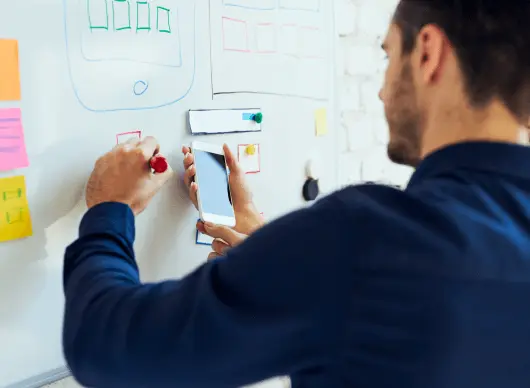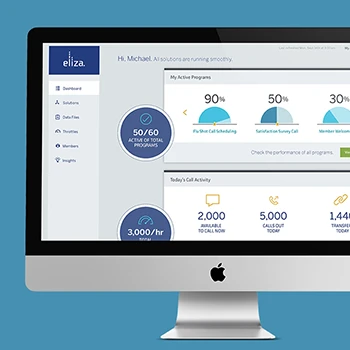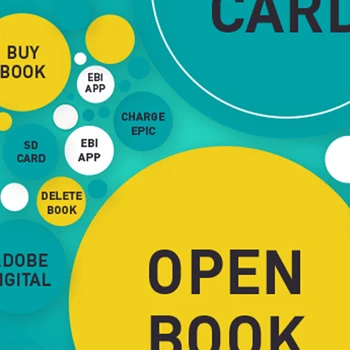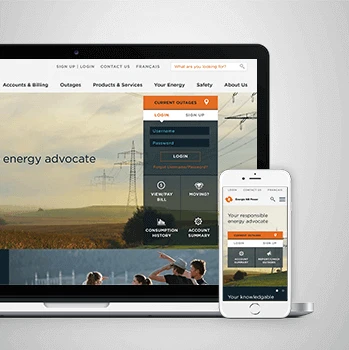What makes digital product design different from traditional product design?
Digital product design focuses on creating experiences across multiple devices and platforms while traditional product design often centers on physical objects. Our Experience Thinking framework addresses the unique challenges of digital products by considering how users interact with brand, content, product functionality, and service delivery across the entire digital ecosystem. We design for touch interfaces, voice interactions, wearables, and emerging technologies while ensuring seamless cross-platform experiences.
Tip: Evaluate potential partners based on their ability to design cohesive experiences across all your digital touchpoints rather than just individual app or website features.
How do you approach digital product strategy development?
We start with understanding your business objectives and user needs through our Experience Thinking lens. This involves analyzing your brand experience, content strategy, product requirements, and service delivery methods. Our approach includes competitive analysis, user journey mapping, technical feasibility assessment, and market opportunity evaluation. We create product roadmaps that align with your business goals while prioritizing user value and technical constraints.
Tip: Ensure your product strategy addresses not just what you're building, but how it connects to your broader customer experience and business ecosystem.
What role does Experience Thinking play in digital product development?
Experience Thinking transforms digital product development from feature-focused to holistic experience-focused design. Instead of building isolated features, we consider how each element contributes to the complete user journey across brand interactions, content consumption, product usage, and service touchpoints. This framework ensures your digital product creates meaningful connections with users while supporting business objectives through intentional experience design.
Tip: Assess whether your current product development process considers the complete user lifecycle or just individual task completion.
How do you balance user needs with business requirements in digital products?
We use our Experience Thinking approach to identify where user needs and business objectives naturally align. Through research and strategic analysis, we find opportunities where improving user experience directly supports business goals. Our process involves stakeholder workshops, user research synthesis, and collaborative prioritization sessions that help teams understand how user satisfaction drives business success rather than competing with it.
Tip: Focus on finding partners who demonstrate how user experience improvements directly connect to your key business metrics rather than treating them as separate concerns.
What is foresight design and how does it apply to digital products?
Foresight design integrates strategic foresight methods with Experience Thinking to anticipate future user behaviors, technology trends, and market changes. Rather than designing only for current needs, we consider how emerging technologies, changing user expectations, and evolving business models might impact your digital product. This approach helps create adaptable designs that remain relevant as the digital landscape evolves.
Tip: Choose design partners who can help you build products that adapt to future changes rather than just solving today's problems.
How do you define success for digital product design projects?
Success metrics combine user experience outcomes with business impact measurements. We establish baseline metrics for usability, engagement, conversion, and satisfaction, then track improvements throughout the design process. Our Experience Thinking framework helps identify the right metrics across brand perception, content effectiveness, product usability, and service quality to ensure holistic success measurement.
Tip: Establish success metrics that measure both user satisfaction and business impact rather than focusing only on traditional usability metrics.
What makes your digital product design approach different from other agencies?
Our Experience Thinking framework distinguishes us by addressing four critical experience areas that most approaches treat separately: brand, content, product, and service. While others might focus primarily on interface design, we ensure your digital product creates cohesive experiences across all user touchpoints. Our approach has been refined through work with technology companies, energy utilities, and media organizations, giving us unique insights into complex digital ecosystems.
Tip: Evaluate design approaches based on their ability to connect your digital product to your broader customer experience strategy rather than just improving individual interfaces.
What research methods do you use for digital product design?
We combine traditional UX research with Experience Thinking methodologies to understand how users interact with digital products across multiple contexts. Our methods include user interviews, usability testing, journey mapping, competitive analysis, and behavioral analytics. We also use participatory design workshops and longitudinal studies to understand how digital product usage evolves over time and across different user lifecycle stages.
Tip: Prioritize research approaches that examine user behavior across multiple touchpoints and time periods rather than just single-session task testing.
How do you conduct user research for complex digital products?
Complex digital products require research methods that can capture multi-layered user interactions and business contexts. We use ethnographic studies, contextual inquiries, and systems mapping to understand how users integrate your product into their broader workflows. Our Experience Thinking approach helps us examine not just product usage, but how the product connects to brand perceptions, content needs, and service expectations.
Tip: For complex products, invest in research that understands your product within users' complete work or life contexts rather than isolated task scenarios.
What's your approach to testing digital products across different devices?
Cross-device testing requires understanding how user needs and behaviors change across platforms. We test core user journeys on smartphones, tablets, desktops, and relevant emerging devices, examining how context influences interaction patterns. Our testing considers not just functionality, but how the experience feels consistent with your brand and meets user expectations across all touchpoints.
Tip: Plan testing that examines user journeys across device switches rather than treating each platform as an isolated experience.
How do you research emerging technology impacts on digital products?
We use foresight design methods to explore how emerging technologies might impact user expectations and product requirements. This includes analyzing technology adoption patterns, conducting scenario planning workshops, and creating prototype experiences with new interaction methods. Our research helps identify which emerging technologies offer genuine value versus those that are primarily novelty.
Tip: Focus on emerging technology research that examines user value and business impact rather than just technical possibilities.
What role does data analytics play in your research process?
Analytics provide behavioral insights that complement qualitative research findings. We analyze user flow data, engagement patterns, conversion metrics, and feature usage to understand what users actually do versus what they say they do. This quantitative foundation helps validate qualitative insights and identify patterns that might not emerge in interviews or testing sessions.
Tip: Combine analytics insights with qualitative research to understand both what users do and why they do it rather than relying on either data source alone.
How do you research accessibility needs for digital products?
Accessibility research goes beyond compliance to understand how diverse users actually experience your digital product. We conduct testing with users who have various abilities, examine assistive technology compatibility, and evaluate cognitive load across different user contexts. Our Experience Thinking approach ensures accessibility considerations integrate with brand, content, and service design rather than being treated as separate requirements.
Tip: Include accessibility testing throughout your design process rather than treating it as a final compliance check.
What methods do you use to understand user emotions in digital experiences?
Emotional research combines observation, interview techniques, and physiological measurement to understand how users feel during digital product interactions. We use emotion mapping, micro-expression analysis, and sentiment tracking to identify moments that create positive or negative emotional responses. This emotional understanding helps us design experiences that build stronger user connections and reduce frustration.
Tip: Include emotional response measurement in your research to understand the relationship between usability and user satisfaction.
What does your digital product design process look like?
Our process follows the Experience Thinking framework through discovery, design, and validation phases. We start by understanding your brand strategy, content requirements, product goals, and service context. Then we create wireframes, prototypes, and visual designs that align these four experience areas. Throughout the process, we test concepts with users and iterate based on feedback before finalizing specifications for development.
Tip: Choose design processes that include regular validation checkpoints rather than waiting until the end to test user acceptance.
How do you approach information architecture for complex digital products?
Information architecture requires understanding both content structure and user mental models. We use card sorting, tree testing, and user journey analysis to organize information in ways that match user expectations. Our Experience Thinking approach ensures information architecture supports brand goals, content strategy, product functionality, and service delivery rather than just organizing features logically.
Tip: Test information architecture with actual users rather than relying solely on internal stakeholder preferences or industry conventions.
What's your approach to visual design for digital products?
Visual design translates your brand strategy into interface elements that support usability and create emotional connections. We develop design systems that maintain consistency across platforms while adapting to different device constraints. Our visual approach considers how design elements support content readability, product functionality, and service interactions within your broader brand experience.
Tip: Ensure visual design decisions are tested for both aesthetic appeal and functional usability rather than choosing based on appearance alone.
How do you handle design for multiple platforms and devices?
Multi-platform design requires understanding how user needs change across contexts while maintaining experience consistency. We create responsive design frameworks and platform-specific adaptations that preserve core functionality and brand expression. Our approach considers how users move between devices and ensures seamless experience continuity across all touchpoints.
Tip: Design for cross-platform user journeys rather than treating each platform as a separate project.
What role do design systems play in your digital product work?
Design systems provide the foundation for scalable, consistent digital experiences. We create component libraries, interaction patterns, and design principles that enable efficient product development while maintaining quality. Our systems incorporate Experience Thinking principles to ensure components support brand expression, content effectiveness, product usability, and service delivery across all applications.
Tip: Invest in design systems that can evolve with your product rather than rigid component libraries that limit future flexibility.
How do you approach interaction design for digital products?
Interaction design focuses on how users accomplish tasks through your digital product. We design user flows, micro-interactions, and feedback systems that feel intuitive and responsive. Our approach considers how interactions support the broader experience journey, ensuring each interaction feels consistent with your brand personality and supports user success.
Tip: Test interaction patterns with real users in realistic contexts rather than assuming what feels intuitive to your internal team.
What's your approach to prototyping digital products?
Prototyping allows us to test ideas quickly before committing to full development. We create interactive prototypes that demonstrate core functionality, user flows, and interaction patterns. Our prototypes help stakeholders understand the proposed experience and enable user testing of critical features before development begins. We use prototyping to validate both usability and business value assumptions.
Tip: Use prototypes to test key assumptions about user behavior and business value rather than just demonstrating how features will work.
How do you ensure designs are technically feasible for development?
Technical feasibility requires close collaboration between design and development throughout the project. We involve technical stakeholders in design reviews, create detailed specifications, and use component-based design approaches that align with development frameworks. Our experience across technology companies helps us understand technical constraints while pushing for optimal user experiences.
Tip: Include development perspectives in design decisions early rather than discovering technical limitations during implementation.
What's your approach to designing for AI and machine learning features?
AI features require careful consideration of user understanding, trust, and control. We design interfaces that make AI capabilities transparent while avoiding overwhelming users with technical complexity. Our approach includes designing for AI training data collection, error states, and user feedback mechanisms that improve AI performance over time while maintaining user confidence.
Tip: Design AI features that clearly communicate what the system can and cannot do rather than creating mysterious black box experiences.
How do you handle performance considerations in digital product design?
Performance directly impacts user experience, so we design with loading times, responsiveness, and data usage in mind. We optimize image usage, plan for progressive loading, and design efficient interaction patterns that minimize server requests. Our designs include performance budgets and fallback states that ensure good experiences even under technical constraints.
Tip: Include performance metrics in your design success criteria rather than treating speed as purely a technical concern.
What's your approach to designing for API integration and data management?
API design affects user experience through data availability, update frequencies, and error handling. We design interfaces that gracefully handle data loading states, connection issues, and varying data quality. Our approach includes planning for offline functionality, data synchronization, and privacy controls that users can understand and manage effectively.
Tip: Design for data edge cases and connection problems rather than assuming perfect API performance in all user contexts.
How do you approach security and privacy in digital product design?
Security and privacy requirements create design constraints that we turn into user experience opportunities. We design clear permission flows, transparent data usage explanations, and security features that feel protective rather than obstructive. Our approach helps users understand and control their data while meeting regulatory requirements and business security needs.
Tip: Frame security features as user benefits rather than business requirements to increase user acceptance and proper usage.
What considerations do you have for designing scalable digital products?
Scalable design requires planning for growth in users, content, and functionality. We create flexible information architectures, modular design systems, and interaction patterns that can accommodate increasing complexity. Our approach includes designing administrative interfaces, content management workflows, and user onboarding processes that work effectively at scale.
Tip: Plan for scale challenges early in design rather than trying to retrofit scalability solutions later.
How do you handle cross-browser and cross-platform compatibility in design?
Compatibility planning ensures consistent user experiences across different browsers, operating systems, and devices. We design with progressive enhancement principles, plan fallback interactions for unsupported features, and test across relevant platform combinations. Our approach balances cutting-edge functionality with broad accessibility to reach your entire user base effectively.
Tip: Define your supported platform matrix early and design within those constraints rather than discovering compatibility issues during development.
How do you optimize user onboarding for digital products?
Effective onboarding introduces users to your product value while minimizing cognitive load. We design progressive disclosure patterns, contextual help systems, and achievement milestones that guide users to success. Our Experience Thinking approach ensures onboarding aligns with brand personality, introduces content effectively, demonstrates product value, and connects users to support services when needed.
Tip: Focus onboarding on helping users achieve their first successful outcome rather than explaining every feature available.
What's your approach to designing notifications and communication features?
Notification design balances keeping users informed with respecting their attention. We design notification systems that let users control frequency, timing, and channels while ensuring critical information reaches them effectively. Our approach considers how notifications support the broader user relationship and avoid becoming intrusive or ignored over time.
Tip: Give users granular control over notification preferences and demonstrate the value of staying connected rather than using notifications purely for engagement.
How do you design for user engagement and retention?
Sustainable engagement comes from delivering consistent value rather than manipulation tactics. We design features that help users accomplish their goals efficiently, create positive habit formation, and build long-term value accumulation. Our approach focuses on making your product indispensable to user success rather than addictive through artificial means.
Tip: Measure engagement quality through user goal achievement rather than just time spent or frequency of use.
What role does personalization play in your digital product designs?
Personalization helps users find relevant content and functionality more efficiently. We design customization options, recommendation systems, and adaptive interfaces that learn from user behavior. Our approach balances automated personalization with user control, ensuring personalization enhances rather than overwhelms the user experience. We consider privacy implications and user understanding of how personalization works.
Tip: Make personalization transparent and controllable rather than creating algorithms that users cannot understand or influence.
How do you design error prevention and recovery for digital products?
Error handling design prevents mistakes when possible and makes recovery simple when errors occur. We design validation systems, confirmation workflows, and clear error messages that help users understand what went wrong and how to fix it. Our approach includes planning for system errors, user errors, and edge cases that create confusion or frustration.
Tip: Design error prevention and recovery flows with the same attention as happy path scenarios rather than treating them as edge cases.
What's your approach to designing help and support features?
Integrated help systems reduce support costs while improving user success. We design contextual help, searchable documentation, and escalation paths that connect to human support when needed. Our Experience Thinking approach ensures help systems align with brand voice, utilize existing content effectively, integrate with product workflows, and connect to broader service offerings.
Tip: Design help systems that anticipate user questions in context rather than creating comprehensive but hard-to-navigate documentation.
How do you approach designing for user feedback and improvement cycles?
User feedback systems help you understand product performance and identify improvement opportunities. We design feedback collection that feels valuable to users, analysis workflows for your team, and communication systems that show users how their input creates positive changes. This creates continuous improvement cycles that strengthen user relationships while improving product quality.
Tip: Close the feedback loop by showing users how their input influenced product improvements rather than collecting feedback without visible response.
How do you collaborate with internal product development organizations?
Effective collaboration requires understanding your existing processes, stakeholder relationships, and decision-making structures. We adapt our Experience Thinking methodology to complement your development workflows, whether you use agile sprints, waterfall phases, or hybrid approaches. Our goal is to enhance your capabilities while delivering excellent design outcomes that fit seamlessly into your organizational context.
Tip: Choose design partners who can adapt to your existing processes rather than requiring you to completely change your development methodology.
What's your approach to working with distributed or remote development organizations?
Remote collaboration requires structured communication and clear documentation practices. We use collaborative design tools, regular video reviews, and detailed specification documents to maintain alignment across time zones and locations. Our process includes regular check-ins, shared progress tracking, and clear decision-making protocols that keep projects moving efficiently despite physical distance.
Tip: Establish clear communication rhythms and documentation standards early rather than trying to coordinate through ad-hoc conversations.
How do you handle stakeholder alignment and decision-making in design projects?
Stakeholder alignment requires understanding different perspectives and creating shared vision around user experience goals. We facilitate workshops that help stakeholders understand user needs, explore design options collaboratively, and make decisions based on evidence rather than personal preferences. Our process creates buy-in through participation while maintaining focus on user value and business objectives.
Tip: Include stakeholders in the design process as participants rather than just reviewers to build understanding and commitment to user-centered decisions.
What's your approach to knowledge transfer and building internal capabilities?
Sustainable design success requires building your organization's long-term capabilities alongside delivering specific project outcomes. We provide training on Experience Thinking principles, document design decisions and rationale, and create processes your organization can use for future projects. Our goal is to make your organization more effective at creating great user experiences independently.
Tip: Invest in partnerships that build your internal capabilities rather than creating dependency on external resources for ongoing design work.
How do you work with organizations at different UX maturity levels?
UX maturity affects how we structure projects and communicate design value. For organizations new to user experience, we provide more education and demonstration of design impact. For mature UX organizations, we focus on advanced methodologies and strategic integration. Our Experience Thinking framework adapts to your current capabilities while helping you advance to the next maturity level.
Tip: Be honest about your current UX maturity level so partners can tailor their approach to your actual needs rather than assuming capabilities you don't yet have.
What's your approach to project management and timeline coordination?
Project success requires balancing design quality with business timelines and resource constraints. We use project management methodologies that provide regular progress visibility, early risk identification, and flexible response to changing requirements. Our approach includes buffer time for iteration and testing while maintaining predictable delivery schedules that support your business planning.
Tip: Plan design projects with enough time for user feedback and iteration rather than trying to compress design timelines to match development schedules.
How do you measure and communicate design project success?
Project success measurement combines design process metrics with user experience outcomes and business impact indicators. We track design iteration cycles, user testing results, stakeholder satisfaction, and post-launch performance metrics. Our reporting communicates both immediate project accomplishments and longer-term experience improvements in terms that matter to your organization.
Tip: Establish success metrics that connect design work to business outcomes rather than just measuring design activity completion.
How do you connect digital product design to business ROI?
Design ROI comes from improved user conversion, reduced support costs, increased user retention, and enhanced competitive positioning. We establish baseline metrics before design work begins, track improvements throughout the project, and measure long-term impact on key business indicators. Our Experience Thinking approach helps identify the most impactful design improvements for your specific business model and user base.
Tip: Focus on design changes that directly impact your primary business metrics rather than general usability improvements that don't connect to revenue or cost reduction.
What's your approach to designing for different business models?
Business model differences require different design priorities and success metrics. Subscription products need different engagement patterns than transaction-based products. Enterprise software requires different user flows than consumer applications. Our experience across technology, energy, and media industries helps us understand how design decisions impact various business models and revenue streams.
Tip: Ensure your design partner understands your specific business model and how user experience design connects to your revenue generation and cost structure.
How do you design digital products that scale with business growth?
Scalable design requires anticipating how user needs and business requirements will evolve as your organization grows. We create flexible information architectures, modular design systems, and administrative interfaces that can handle increasing complexity. Our approach includes planning for international expansion, multiple user roles, and integration with additional business systems.
Tip: Invest in scalable design foundations early rather than rebuilding your product architecture every time your business reaches a new growth stage.
What role does competitive differentiation play in your design approach?
Competitive analysis helps identify opportunities for experience differentiation while avoiding unnecessary complexity. We analyze competitor experiences to understand market expectations, identify gaps your product can fill, and find opportunities to exceed user expectations. Our approach balances following successful patterns with creating distinctive experiences that support your brand positioning.
Tip: Focus competitive analysis on user experience gaps and opportunities rather than just feature comparison to find meaningful differentiation possibilities.
How do you approach designing for global markets and localization?
Global design requires understanding cultural differences, local regulations, and market-specific user behaviors. We create design frameworks that support localization while maintaining brand consistency. Our approach includes planning for different languages, cultural interaction patterns, local service requirements, and regulatory compliance needs across target markets.
Tip: Plan for localization early in design rather than trying to adapt interfaces built for single markets to global requirements.
What's your approach to designing digital products for regulatory compliance?
Regulatory requirements create design constraints that we transform into user experience opportunities. We design compliance features that feel protective rather than burdensome, create audit trails that don't interfere with user workflows, and build privacy controls that users can understand and manage effectively. Our approach turns regulatory requirements into competitive advantages through superior user experience.
Tip: Involve design in compliance planning early rather than adding compliance features after core user experience design is complete.
How do you measure long-term success of digital product design investments?
Long-term success requires tracking user experience metrics, business performance indicators, and competitive positioning over time. We establish measurement frameworks that connect design improvements to sustained business outcomes. Our approach includes user satisfaction tracking, retention analysis, support cost monitoring, and market position assessment that demonstrates ongoing design value.
Tip: Create measurement systems that track design impact over months and years rather than just immediate post-launch metrics to understand true return on design investment.












